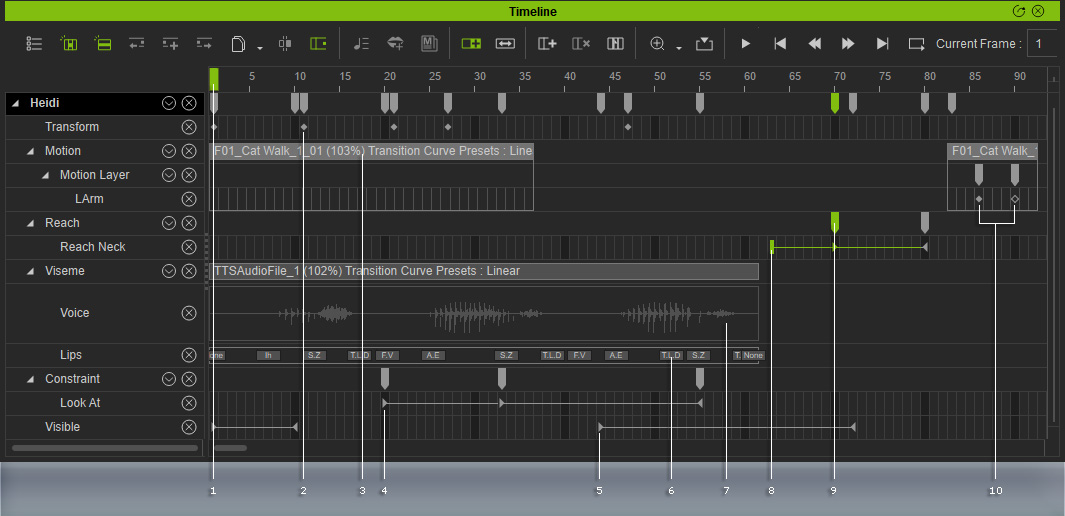Data Types in Timeline
There are nine types of data in the Timeline panel - Key, Clip, Hollow Key, Target-switching, On / Off, Lip-Synching Keys, Voice Wave, Transition Keys and Representative Keys.


|
1 |
Timeline Pointer |
Drag the pointer on the Timeline frame meter for a quick frame review. |
|
2 |
Key |
Animation Key stores RTS (Rotation, Transformation, Scale) data for all objects in the iClone 3D space, including camera, lighting, actors, props, and accessories. Users can use keys on the timeline to control a prop's location, rotation and size change; as for actors, cameras and lighting, only location and rotation can be controlled. Parameter Key stores settings of specific objects such as Color, Range, Beam, Falloff of Lights and Lens, and Focal Length of Cameras. The parameter values between keys are automatically interpolated. |
|
3 |
Clip |
Animation Clip stores motion / animation clip segments of animation data corresponding to animated objects, such as moving / performing / operating of actors / iProps, LiveProps, merged props, and hand gestures. Animation Clips can handle more complicated motion behaviors, such as skin-bone animation and morph animation. A clip may be accelerated / decelerated, looped or blended into another clip. Please refer to the Speed, Loop and Blending section for more information. |
|
4 |
Target-switching |
Target-switching data stores the targeting relationship between one object and its target. The target can be changed or even dissolved at any time frame. Features such as Look at, Link to for actors, cameras, lights or props (Link to only) are under this category. |
|
5 |
On/Off |
The On/Off data on the Visible track stores only one object status. You may make the object visible (on) at one frame, and invisible (off) at another. The On/Off data can also control the emitter of the particle effect to start / stop sending particles. |
|
6 |
Lip-Synching Key (Actor Only) |
The Lip-Synching Key decides lip shapes in certain times as the actor speaks. It may be automatically generated by assigning a voice to a character, or by manually setting one with the Lips Editor panel. |
|
7 |
Voice Wave (Actor Only) |
The Voice Wave shows the waveform of the character's voice. It is automatically generated in order to add lip synching keys at specific times. |
|
8 |
Transition Key |
The Transition Key decides when the reaching action of an actor or following path behavior of an object starts and when it ends. This type of key may be dragged so that you decide the reaching, path-following or releasing speed. It shows only when you select the data on the Reach (Target / Release keys), Path (Position keys), and Spring (On / Off data) tracks. |
|
9 |
Representative Key |
The Representative Key on the Dope Sheet track implies that it contains one or more keys within its sub tracks. Once you change an object's data, you will then be able to add or modify the data in its sub tracks, which will also add or modify a Representative key. |
|
10 |
Solid and Hollow Keys |
Usually, Hollow Keys will appear most when Edit Motion Layer or Sample Clip is applied. This is because iClone 7 performs optimization on all the keys when these commands are executed to make the motion keys more concise. You need to use the Curve Editor plug-in in order to adjust the Hollow Keys. |
